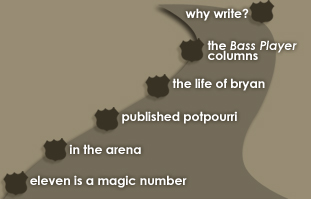
 |
|||||||||
|
|
|||||||||
| Sign up for BellerBytes, the official (and private) Bryan Beller e-newsletter. Just click here to sign up. Do it, OK? | |||||||||
|
Column
#5: Poor Man’s Perfect Pitch You’ve probably seen the ads touting how you can develop perfect pitch in mere seconds. You may have even seen one in this magazine. To paraphrase the late, great Madeline Kahn, “Is it twooo?” Can you really learn perfect pitch? I don’t think so. I’ve been around some pretty sharp ears, and I wouldn’t need two hands to count the number of folks who could identify an F# out of the blue in a split second. A more common talent is the ability to identify any note after hearing a reference note--that’s called relative pitch. If someone plays an E, you can identify any following note using a little interval knowledge. Is it a perfect fifth above? Then it’s a B. A major second down? That would be D. And so on. I’ve developed what I call “poor man’s perfect pitch.” It’s a cross between actual perfect pitch, relative pitch, and just plain cheating. How does it work? Simply pick a song you’ve heard a thousand times--not necessarily your favorite, but one that sticks with you--and practice singing its strongest note (usually the root of the key). Start by doing it along with the recording until you feel you’ve got it nailed--then take off the training wheels and try it a cappella. When you can belt out the note by yourself and verify its accuracy by cranking up the tape while you’re still singing, you’ve got yourself a note. A poor man’s perfect note. The key is finding the right tunes for each note. What songs do I use? Funny you should ask . . . E: Black Sabbath, “Paranoid.” There are so many E’s out there it’s almost silly to pick just one. The verse consists of E, over and over again. Tower Of Power’s “What Is Hip” isn’t a bad choice, either. [BB's note: It turns out that "Paranoid" is actually in E flat. D'oh!] G: Deep Purple, “Smoke on the Water.” When the bass comes in, it makes its way up to that chugging G and just sits there. For a higher-register G I use Led Zep’s “Over the Hills and Far Away”--specifically the acoustic intro, when it lands on the root after the first little lick. D: Led Zeppelin, “Kashmir.” There is no stronger D in rock, period. John Paul Jones’s octaves over the main riff serve it up as fat as it gets. A: The Beatles, “Sgt. Pepper’s Lonely Hearts Club Band.” The pre-vocal intro. Take your pick--either the bass note or the top note of the first two guitar licks. C:
Jaco Pastorius, “Come On, Come Over.” A bassist’s
special. Both of the alternating licks in the verse end with C.
(True confessions: Sometimes I use Men Without Hats’ “The
Safety Dance.” Really.) B: Stevie Wonder, “Sir Duke.” Here’s a fancy one. Again, an opening horn lick. The first four notes begin and end with B’s--but since it’s a major triad from bottom to top, if you can sing them all accurately you’ve just bought yourself D# and F# as well. Not bad for two seconds of memorized music. But you don’t have to have a song for every note. This is where relative pitch comes in. If you know your intervals by ear well enough, maybe you don’t need to memorize Ab or C#. Maybe you need only four or five notes to be able to hear all 12. When you hear a note you don’t immediately recognize, try singing one of your “good” notes and try to get there from where you are. Which notes should you start with? Well, E, A, D, and G seem like nice jumping-off points, don’t they? First you need to memorize some intervals and apply some theory. Say someone plays a C# and you don’t hear it, but you’ve got that E in your head. From E up to C# is a major sixth. What’s the most famous major sixth in history? I say it’s in the NBC bells: From “N” to “B” is a major sixth. Of course, you need to know C# is a major sixth up from E in order for this to work, but you should master that before attempting stunts like this. Some other interval-identifying tunes: Minor second: Theme from Jaws. Duh. Perfect fifth: Theme from Superman--the opening four notes. Perfect fourth: “Wedding March”--a.k.a. “Here Comes the Bride.” Major third: Beethoven’s Fifth Symphony--da da da DAH. When the note changes (or when it goes from “da” to “DAH,” for those of you following my exquisite notation), that’s a major third. This one can be tricky when it appears in a minor context such as this, so it pays to know the interval cold. To compare that to a major third in a major context, try the first and second “na” from the outro of the Beatles’ “Hey Jude.” The intervals may not sound the same, but they are. Minor third: Zeppelin’s “Whole Lotta Love”--the main riff’s first two notes. Suddenly you’ll be glad AOR radio seemed to play it every 30 minutes for 20 years. (I think I just dated myself.) Tritone (augmented fourth/diminished fifth): There are so many in rock. Metalheads can try the main riff of Metallica’s “The Frayed Ends of Sanity” or “Ride the Lightning.” Grunge fans can use the first two vocal notes of every verse in Pearl Jam’s “Evenflow,” or the chorus of Nirvana’s “Heart-Shaped Box” (“I’ve got a new complaint”), or any Stone Temple Pilots song. If you have a hard time with this one, try moving a half-step down from a perfect fifth or a half-step up from a perfect fourth. If you look at this list of tunes and think I’ve just lost it, fine--choose your own songs. The point is that unlike true perfect pitch, the poor man’s version isn’t for gifted freaks only. Using this technique not only can you impress your friends during drunken “name that note” sessions, you can also learn tunes faster on the fly and react more quickly to bandmates’ improvisational whims. Or, in simpler terms, it’ll give you bigger ears. If I ran an ad for Poor Man’s Perfect Pitch, that’s what the headline would say: Get Bigger Ears. Whatever you think of this cockamamie technique, I can assure you from painful experience: It sure beats advanced solfège. By Bryan Beller, copyright 2000 United Entertainment Media. Reprinted from the May, 2000 issue of BASS PLAYER. Reprinted with permission from BASS PLAYER. For subscription information, please call (850) 682-7644 or visit www.bassplayer.com |

|